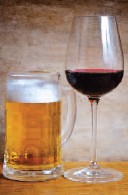Wine and Spirits – Are There Any Benefits?

Does enjoying a glass of wine or beer fit into a healthy lifestyle? Does white wine have the same heart-healthy benefits as red wine? Do “clear” alcoholic beverages equate to fewer calories? Which drinks contain the least alcohol? Up-to-the-minute facts as we know them today are delineated here.
Importantly, this information applies to one drink per day for women and up to two drinks per day for men, according to the U.S. Centers for Disease Control (CDC).
Wine offers heart-healthy benefits. Both red and white wines contain antioxidants that may be beneficial to heart health. Antioxidants can protect our cells against free radicals, which are molecules produced in two ways: when the body breaks down food or by environmental factors (tobacco smoke, pollution). Free radicals damage the body’s cells and may play a role in chronic diseases such as cancer or heart disease.
Red wine contains resveratrol, an antioxidant that may help keep your heart healthy. The Mayo Clinic cites research linking resveratrol to reduced risk of inflammation and blood clotting, factors contributing to heart disease. Resveratrol is found in the skin of grapes used in making red wine. While grape skins are not used to make white wine, the grapes themselves contain other antioxidants which are beneficial. Eating grapes or drinking grape juice offers much the same benefit.
Standard servings of wine, beer and other “hard liquors” contain the same amount of alcohol. The CDC defines a “standard drink equivalent” as 0.6 ounces of pure alcohol. Generally, this amount is found in: 12 ounces of beer, 5 ounces of wine and 1.5 ounces (a “shot”) of 80-proof distilled spirits, such as vodka or whiskey.
Clear liquor, like gin and vodka, contains fewer calories than some other drinks. Most clear liquors, including whisky and rum, contain about 100 calories per standard serving, slightly fewer calories as compared to those in a standard serving of beer or wine. These clear liquors, however, are often mixed with another beverage. Mixing regular tonic with gin, for example, adds approximately 83 more calories.
Beer usually contains more calories than wine. On average, a glass of wine (red or white), contains 120 calories. A 12-ounce serving of beer averages around 140 calories. Craft or stout beers tend to have higher caloric content, while light beers generally have less. Calorie count is indicated on the label. It is interesting to note that beer also contains valuable antioxidants.
Making decisions related to our health are best made with accurate information that takes into consideration solid facts.

